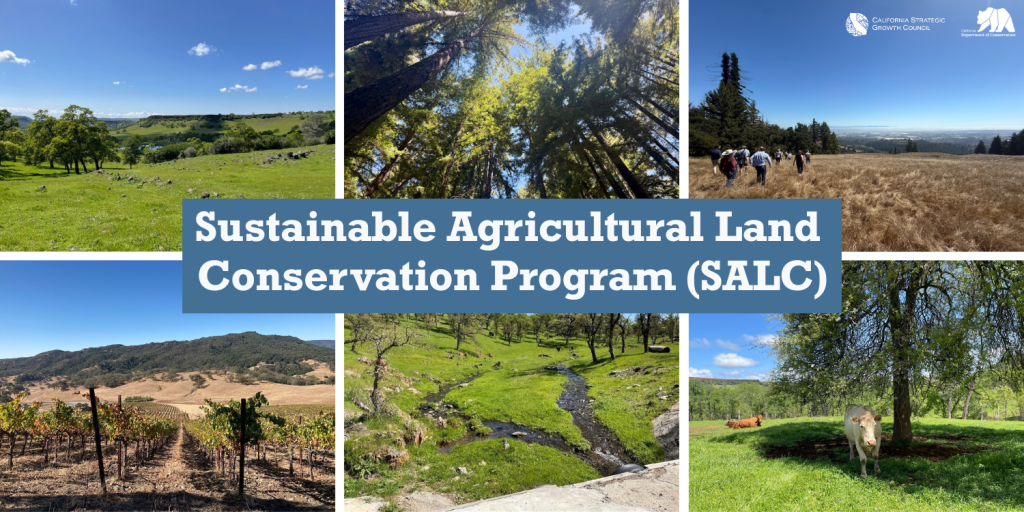Contact: Kalin Kipling-Mojaddedi, kalin.kipling-mojaddedi@lci.ca.gov
EUREKA (10/14/25)—The California Strategic Growth Council (SGC) has approved more than $128 million in Sustainable Agricultural Lands Conservation (SALC) Program grants to permanently protect more than 40,000 acres of croplands and rangelands across 24 counties, with more than 11,000 acres being returned to California Native American Tribes for cultural and traditional agricultural uses.
“Land protection goes hand-in-hand with community needs – today’s grants work with Native communities, veterans, and farmers in low-income areas to ensure that California’s fertile farmland is put to good agricultural use, while protecting our environment, our unique habitats and biodiversity, and communities."
Investments from Round 10 of the SALC Program will fund 52 projects: 48 acquisition grants—39 of which will be for agricultural conservation easements—and four planning grants. Eight of the projects will return 11,316 acres of land to California Native American Tribes, reflecting a $33.16 million investments. Three conservation easement projects will secure land for military veterans, and four projects will do so for landowners in low-income communities, totaling $8.9 million.
It has never been more important to protect California’s working lands from conversion to more pollution-heavy land uses such as residential development. SALC projects that support farmers and protect our open spaces are a win-win, and we are so grateful for the partnership.
Once we lose California’s agricultural lands and open space, we can never recover them. The SALC program protects our state’s agriculture, greenhouse gas emission reduction and biodiversity for generations to come. We are proud to be partnering with the Strategic Growth Council on this important milestone and congratulate all the award recipients on this funding opportunity.
Acquisition grants are for deed restrictions that landowners voluntarily place on their property to conserve the land’s agricultural resources in perpetuity. Conservation easements help prevent the conversion of farmlands to development, which avoids increased vehicle miles traveled and greenhouse gas emissions, and promotes continual carbon capture. They support the local agricultural economy and maintain access to nutritious food, while also protecting native plants and animals and their habitats and supporting sustainable land management practices that help reduce fire risk, among other benefits.
On behalf of Chairman Sundberg, the Trinidad Rancheria Tribal Council, and our Leadership, we extend our sincere appreciation for this grant opportunity. This support enables the Tribe to further its goals of cultural and environmental stewardship, while also creating meaningful programming that fosters cultural and educational opportunities for our tribal youth and members. Through this initiative, we are empowered to manage our forest lands with care and intention, and to preserve and share our traditional lifeways for generations to come.
Out of a total of 74 applications, 42 were developed using SALC capacity and project development funding support from a previous round, and 33 (45% of applications submitted) are being awarded.
The capacity, planning and acquisition grants that SALC provides have been instrumental in helping us develop and implement projects as well as deepen our partnership with the Nevada City Rancheria Nisenan Tribe. We used capacity funding to develop a tribal acquisition project. The California Heritage: Indigenous Research Project, the Nisenan Tribal nonprofit, was able to prepare and submit a grant for the fee-title acquisition of a 420-acre ranch in Yuba County … This is a monumental step in getting land back to the Tribe and crucial for restoring cultural practices, revitalizing traditions, and ensuring the continuation of tribal stewardship. The multiple benefits that projects like these provide to the state not only protect local food security and biodiversity but also help reach our 30×30 goals. Our work would not be possible without the SGC and DOC staff’s passion, leadership and commitment to conservation.
Once completed, acquisition investments from Round 10 will permanently protect tens of thousands of acres and reduce greenhouse gas emissions by an estimated 3,332,497 metric tons of carbon dioxide equivalent, which amounts to taking 777,322 gasoline-powered vehicles off the road for one year.
The awards were announced at the Oct. 8 SGC Council Meeting in Eureka. SALC will continue with Round 10 awards at the December SGC Council Meeting, recommending Capacity and Project Development projects for awards.
SALC is a subprogram of SGC’s Affordable Housing and Sustainable Communities (AHSC) Program. The two programs work together to ensure that California is building affordable new homes quickly, in the right places, while protecting open spaces and working agricultural lands at risk of development.
Through funding for smart planning and land use, strong partnerships and community-centered solutions, California is supporting and uplifting California families, communities and the environment.
About the California Strategic Growth Council
The California Strategic Growth Council is led by a council of six agency secretaries, three public members, and the Director of LCI as its chair. This unique structure provides a pathway for broad implementation across state agencies. SGC collaborates with partners across public, private, and nonprofit sectors to elevate community voices at the state level and ensure that California’s vision for the future is informed by its residents, especially those marginalized and underserved. SGC helps communities identify and fund the projects that will make the state’s long-range goals a reality. Together, LCI and SGC connect all levels of government with the communities they serve, future plans with present action, and technical expertise with lived experience.
About the Sustainable Agricultural Lands Conservation (SALC) Program:
SALC is a component of the SGC’s Affordable Housing and Sustainable Communities Program (AHSC). It complements investments made in urban areas with the purchase of agricultural conservation easements, development of agricultural land strategy plans, and other mechanisms that result in GHG reductions and a more resilient agricultural sector. The program invests in agricultural land conservation with revenue from California Climate Investments made available for projects that reduce greenhouse gas emissions while providing additional benefits to California communities. California Climate Investments are derived from quarterly Cap-and-Invest, formerly known as Cap-and-Trade, auction proceeds. The California Department of Conservation works in cooperation with the California Natural Resources Agency as SGC’s implementation partner for the program.
